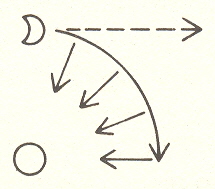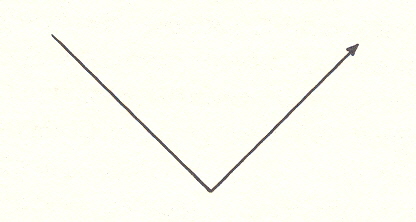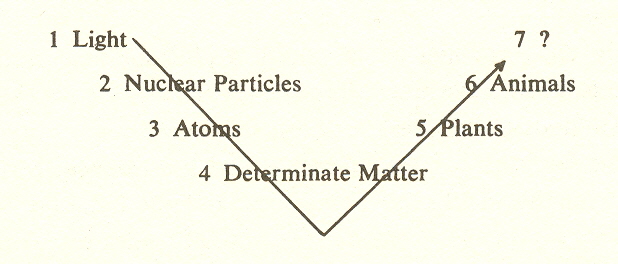*
THE FALL
Cumulative nature of process
In the Introduction I have explained how I was first led to a theory of process by the importance of time, then to the idea that process must have seven stages, and from that to seven kingdoms in nature. The concept that each stage was itself a process provided additional information. Finally, the assignment of the first stage to light took me to quantum physics and to the realization that the quantum of action is fundamental.
Now consider this sequence of kingdoms:
Light
Particles
Atoms
Molecules
Plants
Animals
(Man)
A moment's reflection will reveal that these kingdoms or powers are not different sorts of things, like peas, apples, and oranges. The relationships which they exhibit are of another order: they are cumulative, they include one another, in the sense that animals include the principle of cell division first developed in plants, plants organize molecules, molecules combine atoms, atoms organize protons and electrons, and the latter are in turn convertible into photons. Each kingdom, and each power, includes what has gone before and adds a contribution of its own. Each kingdom is a level of organization which depends on the one preceding.
Necessity of distinguishing levels of organization
One often hears it said, even by good scientists, that man is just a bunch of molecules, as if to deny any right he might have to a status of his own. The statement even denies him status as an animal, or as a cellular organism. This is nonsense. If one denies the animal level of organization or the cellular, one must deny the molecular, for a molecule is nothing but atoms, and the atom is nothing but protons and electrons. And lest one might think that here we have solid ground, it then appears that the electron is nothing but a "probability fog" or, if we press further, a quantum of action (a photon) that has frozen into mass.
I am not objecting to the sweeping away of all categories, as implied in the Hindu tradition with its insistence on the "ego-lessness" of things, or in the big bang theory of the universe as having been created by an initial explosion, or in the theory of its ultimate collapse into a singularity. My objection is to the singling out of molecules or of atoms for special sanction. Why stop there? It is true that molecules have, at ordinary temperatures, a relative permanence. Is it this appearance of stability that commends them, like the billiard balls, as the ideal reference that science can accept?
Man asks for bread, and science gives him a stone. He had better turn back to the old myths and get the story of the wholeness.
The fall as revealed by the discoveries of science
This brings me to one more basic idea which is important to the theory of process, an idea that is expressed in the old myths, in Plato, in almost every religion: that of a fall, a descent into matter, often though not always followed by an ascent back to celestial spheres and a higher state of being. This idea is rather at odds with current rational thinking, which regards itself as having outgrown such superstitious guilt-ridden notions, and as now enjoying the "enlightenment" provided by science.
However, recent developments in physics, quantum physics in particular, when properly understood, provide confirmation for the ancient notion of a fall. We may now show that it is true, in fact, that a fall occurs, for the same process by which light first precipitates or condenses into matter - losing a degree of freedom in exchange for permanence - is continued with the generation of atoms and again with their combination into molecules, so that in the grand scheme of evolution the first four stages constitute a descent from the freedom of light to the inertness that characterizes minerals (see end of this chapter).
Science has been able to discover laws of matter by restricting itself for the most part to inert objects. Galileo found the laws of falling bodies by dropping weights, not birds or moths. By concentrating on inert objects, science has made enormous progress, and there is no questioning its discoveries insofar as they are applied to their proper province, namely, to molar objects - objects containing so many particles that the agitations of individual particles cancel out and the gross object is inert.
Newton described himself as "standing on the shoulders of giants," meaning that he built on the work of his predecessors Copernicus, Kepler, and Galileo. It was he who recognized that the same law which causes an apple to fall also causes the moon to revolve around the earth.
Gravity pulls the moon out of the straight line and into the circle of earth
Newton's theory of gravitation made it possible to accurately predict the motion of the planets. It gave science its first comprehensive theory and laid the basis of the billiard ball hypothesis, the belief that the universe could be accounted for as the motion of inert objects interacting according to exact laws. Up until fifty years ago, the expectation in physics was that this belief would apply all the way down to the ultimate constituents of matter, be they atoms or whatever.
The existence of atoms was first hypothesized by science to account for what were called combining ratios. Soon after 1800 it was found that whenever different materials were combined to create a third - as oxygen with hydrogen to form water, or
- they did so in fixed ratios: 8 grams of oxygen to one of hydrogen. This fact could be explained by supposing that all materials are composed of atoms whose relative weights are in fixed ratio. This hypothesis proved quite satisfactory and could be extended to all materials, despite the fact that the absolute size of the atom was unknown.
Not until 1900 was it possible to actually count the atoms in, say, a gram of hydrogen. The number was found to be huge: 6.02 times
atoms in one gram of hydrogen or in 16 grams of oxygen. (The oxygen atom is sixteen times the weight of the hydrogen atom and, of course, combines with two hydrogen atoms in
, making the combining ratio 8:1.)
But no sooner had the atom been at last tracked down than there came a disconcerting discovery: the "indivisible" atom was made of parts! And these parts, of equal and opposite electrical charge, were unequal in weight: the proton is eighteen hundred times heavier than the electron.
Then came the question: how big is the proton? In an ingenious experiment, Rutherford bombarded atoms with alpha particles (helium atoms with electrons stripped off), and showed that the proton could be no larger than
centimeter - about 1/100,000 part of the whole atom! This was another surprise, for it emphasized still further how utterly minute were the nuclear particles of the kingdom prior to that of atoms.*
*I neglect the transitory particles - mesons, etc. - because of their brief life spans, about one-billionth of a second.
But the fact that atoms had turned out to be divisible, despite the indivisibility they were formerly thought to possess, provided a beautiful simplification, for now it was possible to account for the ninety-two different atoms as made up of only two ingredients, the electron and the proton! And it was also found that the chemical and other properties of atoms depended solely on the number of electron-proton pairs. The number of such pairs is called the atomic number. Each kind of atom has thus a different number assigned it, and every possible number of proton-electron pairs up to ninety-two is a different kind of atom.
A more eloquently simple way of obtaining the complexity of matter, with its ninety-two kinds of atom and its countless kinds of molecule, cannot be conceived. It confirms in yet another way the insight of Pythagoras that all is number.
So the discovery that atoms could be divided into more elementary constituents was a triumph of rationality. I should say another triumph, for meanwhile the precise frequencies of the light radiated or absorbed by atoms were accounted for in Pythagorean fashion as the ratios of whole numbers. Simple, elegant, rational, the entire behavior and structure of atoms could be figured down to the last decimal point. The rationality of science enjoyed an undreamed-of triumph. The billiard ball hypothesis was apparently confirmed.
Uncertainty enters the picture
But then, from an unexpected quarter, came a shattering blow. So far, in working out the details of atomic theory, it had been assumed that the ultimate units, the proton and electron, were the same kind of thing as inert objects - that they were just very small billiard balls, but in other respects like ordinary objects such as grains of sand or specks of dust. However, this assumption had overlooked an important consideration: how are you going to see these small particles? The denouement was like Portia's caution to Shylock in The Merchant of Venice, that he may have his pound of flesh, but if he sheds one drop of blood his life is forfeit. In the modern version, Heisenberg has the role of Portia. He pointed out that for the presumption of predictability to be carried out, it is necessary to observe the position and momentum of this tiny particle. And to observe it we must throw light on it - right? But the wavelength of ordinary light (
centimeter) is a million times greater than the diameter of the particle you are observing; so it won't provide any accuracy (a difficulty that limits the resolving power of optical microscopes to three-thousand-fold).
Very well, let's use shorter-wavelength light. But since this shorter wavelength light (x-rays) is in the form of photons which carry enormous energy, their impact upon the particle will knock it out of the picture.
Hence the predicament: the observation of position and momentum required for prediction cannot be carried out, and the determinism we were led to expect at the level of molar aggregates (objects made of billions of particles) does not hold for elementary particles; their position and momentum are indeterminate.
Reader, do you sense what's going on? Or do you feel perhaps that some probe finer than light can be found which will make possible the observation without the disturbance? Many scientists have felt the same, for one does not like to give up one's faith that the universe can be known, or in other words, that it is objective. But as Heisenberg was at pains to point out, we are up against not merely the physical limitation of an instrument which a better instrument might circumvent. We encounter here a principle which imposes a theoretical limit on the accuracy of our knowledge about individual particles.
For however we vary our probe, the uncertainty is the same; we can measure position with accuracy only at the expense of disturbing the momentum, and we can measure momentum only at the expense of disturbing the position; the product of the two uncertainties is a constant.
Implicit in this dilemma is an important philosophical principle: the observer can know the universe only by interacting with it, and this interaction requires more energy as the accuracy of observation increases. A remarkable finding, for it makes zero as unattainable as infinity!
But our concern in the present context is with the entry of uncertainty into the picture. The predictability which held for molar aggregates (stones and other inert objects) is not possible with ultimate particles. It might be objected that the uncertainty is introduced by the act of observing them (epistemological). But it has been found that the particles carry or possess the uncertainty anyway (ontological.)* There is only a probability that they are in a given place. The electron is now referred to as a "probability fog."
*That the electron "possesses" an innate uncertainty is implicit from the definition of the fine structure constant. See p. 35, "level II," See also Northrop's introduction to Heisenberg, wherein Northrop emphasizes that the uncertainty of the electron is ontological, not just epistemological. Heisenberg, W. Physics and Philosophy. New York: Harper and Row, 1958.
Another attribute of these fundamental particles, protons and electrons, is that they have no identity. It is impossible to know whether an electron leaving an atom is the "same" electron as the one which entered it. In order to carry on with the task of science, to discover laws and to predict, the physicists have given up attempting to deal with individual particles. Like insurance companies, they must use statistics. They even have different kinds of statistics for different kinds of particles: Boltzmann statistics for molecules that can be distinguished; Fermi-Dirac statistics for electrons that cannot.
I will not dwell on this here except to stress that our story has a moral: the world of fundamental particles is quite different from that of predictable billiard balls. From the point of view of predictability, it is like that of human beings. Its creatures have a life of their own. Predictability here is similar to that of insurance tables, Gallup polls, and market surveys: it does not apply to individuals. The individual particle does not obey laws.
The fall into determinisn
Why is this important? Because here in science we discover that the evolution of matter itself is a "fall." By fall we mean loss of freedom, increase of constraint. This occurs in steps: first the condensing of the original energy of the photon into mass to form a charged particle, then the joining of opposite charges to constitute - a neutral atom, then of atoms to form molecules, and finally the compaction of molecules into inert objects. In this declension the original freedom is lost: the free motion of one particle is canceled by the free motion of another, so that where billions of particles are compacted, there results an inert object, which, having no self motion, responds to exact laws.
It is these inert objects that are the basis for the so-called universal laws. It is these objects and only these that do not move unless pushed.
We must therefore interpret the generation of matter - of the universe itself - as a fall into determinism.
Beyond determinism
But this is not the end of the story. There are higher forms of organization. Not all molecules are compacted into inert objects. There are some which are organized into living creatures: plants, animals, human beings. Can we read these higher forms as an ascent a "return" - to freedom?
I believe we can, and I will introduce this image of an "arc" as a basic postulate. It is one of the concepts I will use in the theory that I am setting forth. I could also say that I found it borne out, for in examining the kingdoms it became evident to me that there was a fall followed by an ascent: the first and final kingdoms being most free and the ones in the middle the most determined.
It is almost self-evident that this should be the case, for process, as the dictionary defines it, consists of steps taken to reach an end "as in the process of making steel." Therefore any process projects a goal and goes through means to attain it. Such means are necessarily determinate or predictable. If our presumed means do not function as we expect, we find other ways to achieve the end. If our car breaks down, or in any way becomes unpredictable, we resort to other means of transport. (See discussion of the work of an inventor in the Introduction.)
The reader might ask if the increase in determinism which science has discovered in the generation of matter is properly interpreted as a fall of the same kind as described in myth.
In answer, let us cite the Egyptian myth which begins when Osiris is trapped by Set in a coffin fashioned for the purpose. The coffin then floats down the Nile and comes to rest at the base of a tamarisk tree, which grows up around it, enclosing it. Finally, Osiris is dismembered by Set and the pieces strewn in the marsh. (The myth continues with Isis, who reassembles the pieces and conceives from the corpse the infant Horus, who becomes the hero who conquers Set.)
This myth, with its description of increasing constraint, first by the coffin and then by the enclosing tamarisk tree, presents the fall in terms of loss of freedom. The next stage, the dismemberment of Osiris into pieces, involving total loss of any possible initiative or self-motion, represents a state of complete inertness or determinism.
The reader may object that the story of Osiris, like the third chapter of Genesis, refers to the fall of man, not to the generation of matter. But I insist that both myths nevertheless describe process and its necessary descent into means to attain its end. The advanced stages of organization which constitute life must have determinate matter to work with: Osiris must be dismembered in order that Horus may be born. This is the universal pattern of process, experience, development.
The arc
We may therefore depict this descent and ascent through which process develops as an arc:
The mere idea of a fall gives only the overall picture, but this arc arrangement yields clues to why process is what it is. By visualizing the seven stages as occurring on four levels, each having a distinct character, we can uncover further details which will be developed in succeeding chapters.


